Sako Ups Their Game
It’s Tough to Improve the Venerable M85, But They Did Just That With the New Sako 90
By Jon R. Sundra
Originally published in the March/April 2024 issue of Safari Magazine.
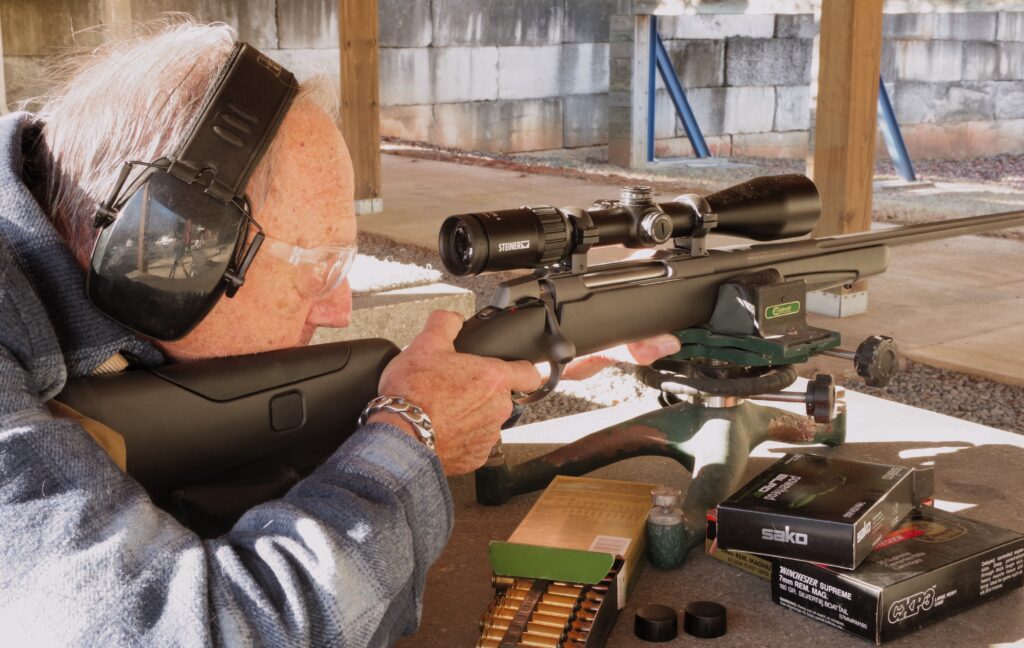
There are a few adjectives that can be used to describe Finnish-made Sako rifles, but if you were to choose well designed, well made, accurate and reliable, you’d get no argument from me.

The company’s roots go back to 1921 when it started repairing and refurbishing Mosin-Nagant M91 service rifles that had been the martial arm of both Finland and Russia during WWI.
The first civilian rifle to bear the Sako name was the L42 that Firearms International began importing here around 1948 as the Vixen, a miniaturized Mauser-type action that proved to be perfectly scaled to the .222 Rem. cartridge that would be introduced in 1950.
In 1957 the medium-length L579 Forester action was introduced, and in ’59 the magnum-length L61 Finnbear was rolled out.
It was this period when I became an ardent Sako fan.
Shortly after selling my first article in 1966, I assembled what to me were the two most perfect rifles I could envision at the time; rifles I could see myself using the rest of my life. Both were based on the L61 action, one which I had custom barreled in .25-06, the other in 7mm Rem. Magnum, and for both I had the chamber throat extended to allow me to seat bullets shallower than SAAMI specs. I stocked and glass-bedded both myself using Fajen’s racy-looking Regent stock in wood laminates. (Yes, I was a fan of laminated stocks long before they became popular).
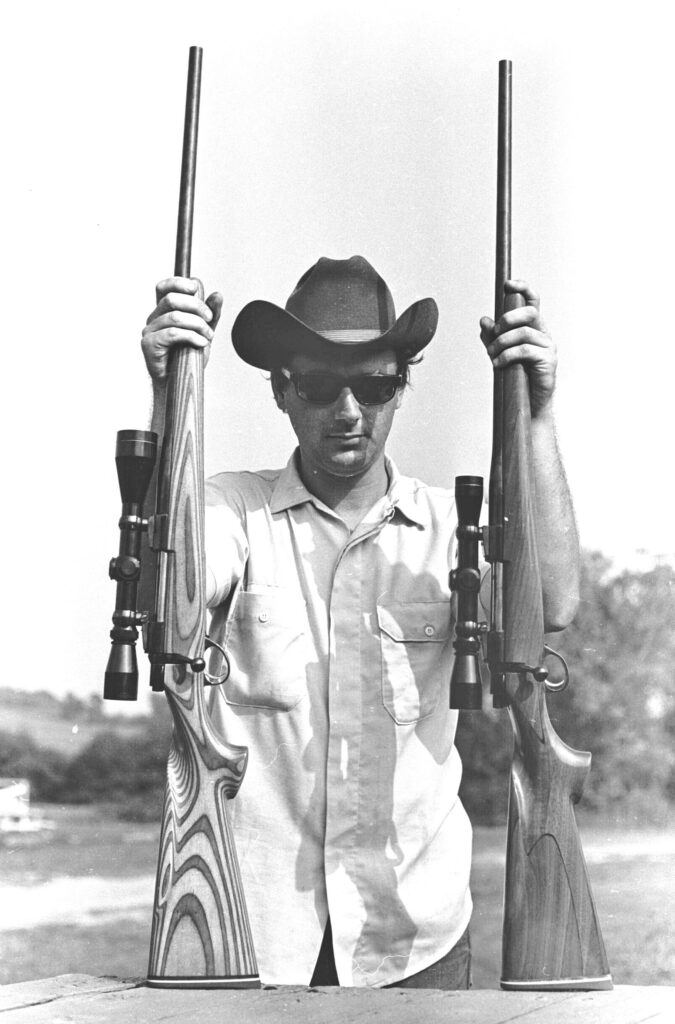
In 1991 the Sako TRG emerged. It was a tri-lug tactical rifle, the company’s first departure from the twin-lug Mauser-type action. It was also the precursor of the M75 series that spanned 1996 to 2006. Then came the Model 85 series, which this year is being replaced by the M90. It should be noted that the M85 was offered in 25 distinct models based on four action lengths and six iterations thereof, making what I’m pretty sure was the most comprehensive selection of bolt action rifles ever offered.
In 2000, Sako was acquired by Beretta and remains so today as the company’s exclusive importer/distributer.
The example sent us for T&E was the Sako 90 Adventure, their second least expensive model that comes standard with a fiberglass stock. Chambered in 7mm Rem. Magnum, with its 24.4-inch cold hammer-forged barrel it measures 45.4 inches in overall length and weighs 7 1/2 pounds. Ours came with a fluted barrel, the one option offered. Smooth or fluted, the barrel has a 1:9.5-inch twist rate and a threaded muzzle with a protective cap.
The differences between the 90 and its forebearers are significant, and definitely improve on what was an already a very fine rifle in the M85.The most obvious difference is the integral 6-slot Pic rail that replaces the Sako tapered dovetail system that was standard on most previous models going all the way back to the original L-series. By switching systems, the mount options on the M90 increase exponentially.
Another obvious change is the shape of the ejection port. It actually looks larger than that of the M85 but combined with the new geometry dictated by the presence of the integral mount rail, Sako claims this receiver is more rigid. Always known for rifles of clean, uncluttered design, the M90 continues that tradition.
The forged receiver is quite attractive, with a facet at the left side bearing the model, serial number and proof marks in small, subdued lettering. The bolt stop/release at the left rear of the bridge is also of minimalist design, and the shroud at the rear of the bolt provides a very attractive silhouette.
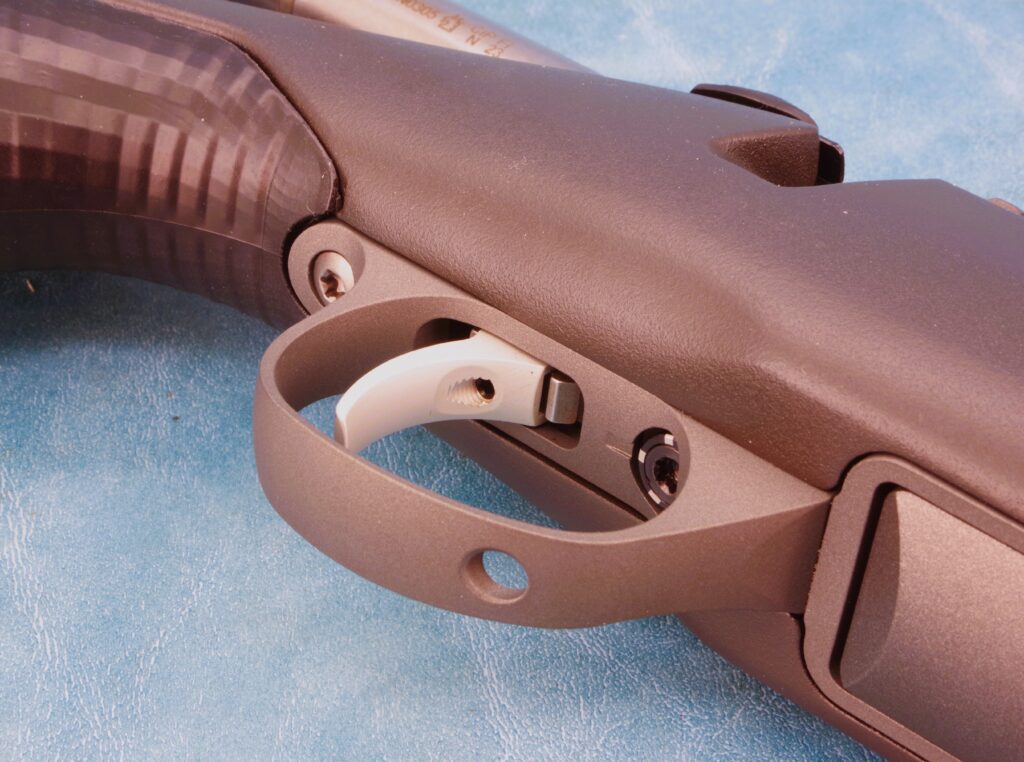
At first glance the tri-lug bolt appears to be the same as that of the M85, but on closer examination one finds there are two plunger ejectors housed within a recessed bolt face, two features which negate controlled-round feeding. I find this puzzling, because the M85 was a controlled-round-feed action, and in my memory, I can’t recall any manufacturer switching from controlled round to push feed! It’s generally the opposite, as evidenced in the evolution of the Ruger 77 and Winchester Model 70.
The M90, then, is a tri-lug, push-feed action. The redundancy of having dual ejectors ensure absolutely reliable ejection. In fact, Sako claims the M90 survived 5 million cycles without a single ejection malfunction! The ejectors are positioned in such a way as to preclude empties from glancing off the bottom of the windage scope turret — something I’ve experienced with a few guns over the years.
And I can recall a couple instances where the spent case actually bounced back into the port — something you don’t want if you’re facing a charging buffalo! It’s just another example of Sako’s obsession with details. No feature in the design and manufacture of a Sako rifle is implemented without the consensus of a design team comprised almost entirely of hunters and/or competitive shooters.
I know, because for over the decade that Sako was imported by Stoeger, I served as their press relations consultant here in the U.S. I’ve toured the factory in Riihimaki and hunted moose in Finland a number of times.
Anyway, being a tri-lug action, bolt rotation (handle lift) is appreciably less than the 90-degrees required of a twin-lug action. With the M90, it’s 70 degrees, so there’s lots of clearance between one’s hand and the scope’s eyepiece when cycling the action. Speaking of cycling the action, this is one of the smoothest I’ve come across in a long time.
With a bone-dry bolt, it glided effortlessly, and with a little Break Free applied, tilting the rifle just 15-16 degrees was enough for the unlocked bolt to slide open of its own weight. That, sports fans, is smooth!
And to cock the action, it took but 7 pounds of upward force on the bolt handle, meaning this rifle could easily be cycled with the gun shouldered.
The side safety is a 2-position affair that locks the bolt when engaged, but just in front of the thumbpiece is a second, smaller button that bypasses the bolt-locking feature and allows the action to be cycled with the safety engaged. The trigger is unique in that not only can it be adjusted to five different pre-set values ranging from 2 to 4 pounds without having to remove the barreled action from the stock, but the position of the trigger within the guard bow can be changed fore and aft to suit one’s individual preference.
The bottom metal unit is non-ferrous and combines the trigger guard bow and the frame for the detachable magazine. The latter is of heavy gauge stainless steel and can be charged by simply pushing rounds downward through the feed lips, and it accepts them without a fight.
Additionally, the magazine can be charged through the ejection port, something that cannot be said for many DM rifles. When in place, the magazine fits dead flush with the belly of the stock and looks very much like a hinged floorplate. It’s just about the best-looking DM unit I’ve seen, and it holds 4 rounds of belted magnums.
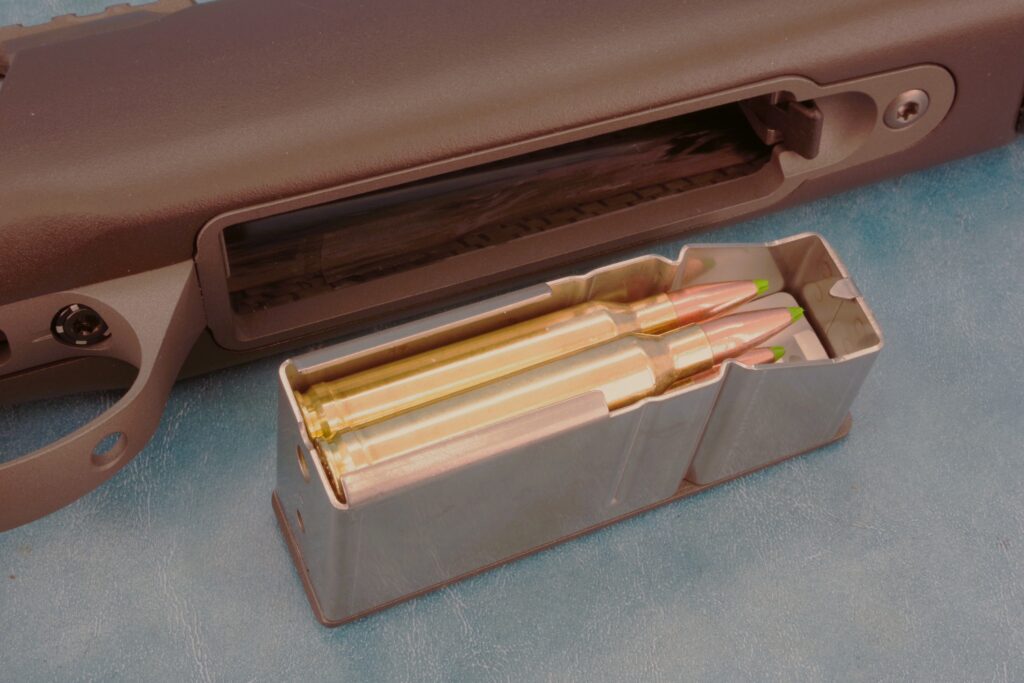
As an added measure, to ensure the magazine cannot be released accidently, the front end of the floorplate must be pushed upward before the release button can move. It takes a push of just 1/16-inch, but without that movement the box stays locked in place.
Another feature I especially like is that the magazine is of true magnum length and will accept cartridges loaded to an overall length of 3.7 inches, which is .410-inch longer than commercial ammo. If you’re a handloader and willing to spend the few bucks it costs to have the chamber throat extended, you can gain as much as 100 fps due to the increase in usable powder space.
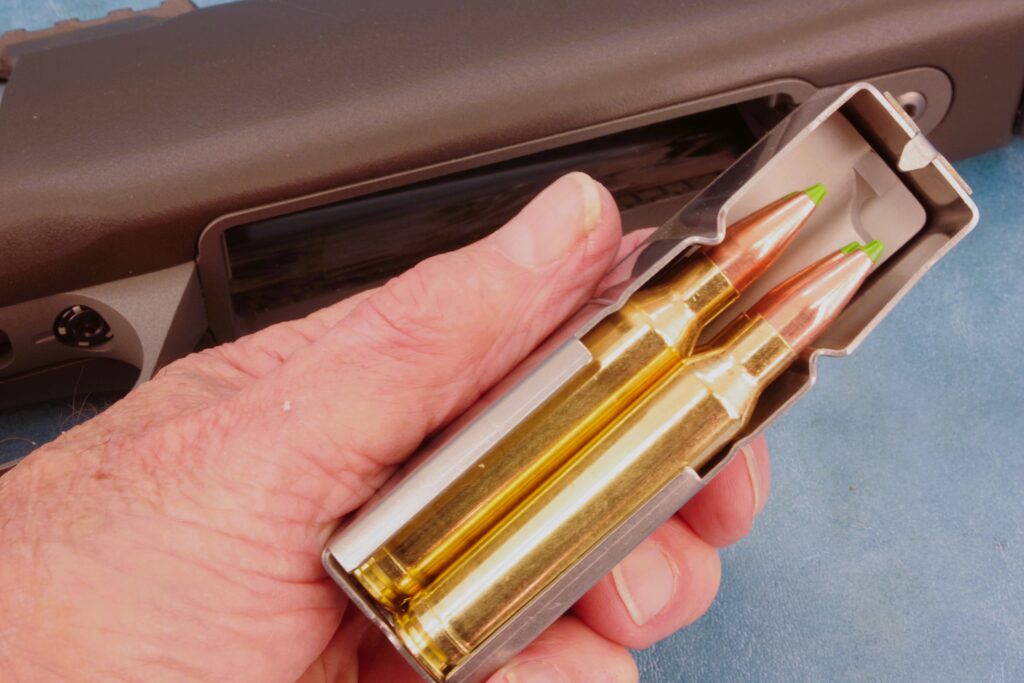
The Adventure’s stock is of fiberglass, and upon removing the barreled receiver, which is of stainless steel and treated to a light gray tungsten Cerakote matte finish, one finds that the receiver area is reinforced with carbon fiber. It’s another of those details that make a Sako a Sako.
Rubberized panels adorn the grip and fore-end areas, and the butt is fitted with an effective semi-soft recoil pad. The adjustable comb is controlled by a square button on the right side of the stock. Depressing the button allows a height adjustment up to 1 inch in 1/8-inch increments.
To ready our example for a little range work we mounted Steiner’s superb Predator 4-16×50 scope using Burris’ Signature Zee rings. It was an absolutely perfect match in that the ring span using the forward rail notch both fore and aft, precisely matched the scope’s body length.
When a ring span is shorter than the body tube, the scope itself is less able to withstand a hard knock or drop without losing zero. Most scopes will answer the helm when you’re making adjustments by the inch, but few will answer accurately when you’re trying to make small changes in zero. This one did.
On the range or in the field, spending time with a Sako has always been a pleasurable experience for me, and this was no exception. Sako claims its 1.3 millisecond lock time is fastest among sporting rifles, and I believe ’em.
Not only is it instantaneous, but there is no discernible creep, and it breaks like the proverbial glass sliver. Cartridge feed was smooth and effortless, and spent cases ejected like they were self-propelled.
And accuracy? I’ve tested rifles that shot tighter groups, but very few that averaged 1.07-inch with four different brands of ammo and three bullet weights!
Simply put, every aspect of the test gun worked so seamlessly, so definitively, that I can find nothing to criticize. The M90 is one helluva rifle, as is Steiner’s Predator scope. The Adventure carries an MSRP of $2,999. In this the first year of production, 14 chamberings are being offered ranging from .22-250 to .300 Win. Magnum.
Headline: Accuracy Test
We shot five three-shot groups of four different kinds of ammo with three different bullet weights through the new Sako M90 in 7mm Rem. Magnum from a bench at 100 yards.
LARGEST GROUP SMALLEST GROUP AVERAGE
Sako 140-gr. Blade Powerhead 1.15 inch .70 inch .90 inch
Federal 140-gr. Trophy Copper 1.40 .95 1.15
Winchester Supreme 160-gr. Silvertip BT 1.55 .95 1.20
Remington 165-gr. Extended Range 1.25 .55 1.05

